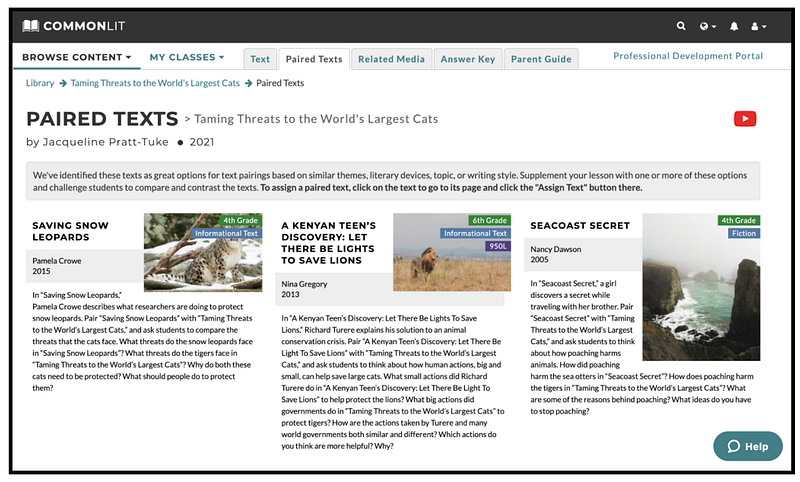These informational texts for grades 3–5 teach students how conservationists are working to protect animals around the world.
Students love learning about animals, but it can be discouraging when they hear about the threats animals face in the wild. Reading about how humans are working to protect animals is a great way to inspire your students and give them ideas for ways they can help too!
Here is a compelling selection of informational texts for grades 3–5 from CommonLit about how scientists and conservationists are helping animals around the world.
“What’s the Buzz About Bees?” by Jacqueline Pratt-Tuke (5th Grade)
In this article, Jacqueline Pratt-Tuke explains what bees do for the world around us. Honey bees are pollinators and help produce some of our favorite foods, like apples, watermelon, and avocados. However, the bee population has been rapidly declining because of human pesticide use and parasites that attack colonies. Fortunately, beekeepers and scientists are figuring out the best ways to save honey bees.
After reading, have students learn more about the process of pollination by watching the video “Flowers and Their Pollinators: A Perfect Match!” under the Related Media tab. Then, as a science extension, students can make a poster or timeline that shows the steps of pollination in order.

“No Petting the Orangutans, Please!” by Arlene Mark (5th Grade)
In this text, the author describes traveling with scientist Dr. Biruté Galdikas to help rescue a young orangutan, Biki, that is being kept as a pet. Orangutans are endangered because of habitat destruction. When loggers cut down forests, they often steal baby orangutans to sell as pets. Luckily, Dr. Galdikas is able to convince Biki’s owners to release him to a wildlife rehabilitation center to learn how to survive in the forests on his own.
After reading about orangutans, give students the opportunity to be creative conservationists! Have students research the endangered animal of their choice. Then, they can make a poster with suggestions for how people can help protect this animal and share their artwork with their classmates.
“Taming Threats to the World’s Largest Cats” by Jacqueline Pratt-Tuke (5th Grade)
In this text, Jacqueline Pratt-Tuke describes the threats tigers face and what is being done to help them. Habitat destruction, poaching, and tiger farms are the biggest factors that endanger these big cats. Thirteen Asian countries have taken action to counter these threats, and as a result, the worldwide tiger population is increasing again.
Consider pairing this text with “Saving Snow Leopards” by Pamela Crowe, which describes the challenges these mysterious big cats face. After reading the two texts, students can compare and contrast conservationists’ goals and strategies to help tigers and snow leopards.

“How to Find a Tortoise Nest” by Alexandra Wells (3rd Grade)
In this informational text, Alexandra Wells describes her time working with scientists looking for baby desert tortoises in the Mojave Desert. Desert tortoises are listed as “threatened” under the Endangered Species Act. Wells describes how scientists follow trails to learn where the tortoises go and where they lay their eggs.
After reading, have students discuss one the desert tortoise’s main adaptations. Ask Discussion Question 2, “Tortoises spend most of their lives underground. How does living underground help the tortoises? What other animals can you think of that live underground?” Students can discuss how the tortoise is well-adapted to live in its habitat and make connections to similar animals.
“Standing Out in the Herd” by Cecil Dzwowa (5th Grade)
“Standing Out in the Herd” is a heartwarming informational text that describes how an orphaned giraffe finds a surprising new family. Toro the giraffe was rescued by herders after his mother was killed by lions. The herders moved Toro to a farm to raise him with a herd of cattle. Toro was easily accepted by the herd because giraffes and cattle have many of the same behaviors. Though Toro cannot be returned to the wild, he has found a home living among the cows.
It is always fun for students to learn about unexpected animal families and friendships. Use Discussion Question 1, “In the text, Toro joins a herd of cows. Do you think the cows consider Toro to be part of their family? Why or why not?” to start a conversation about the ways animals interact with each other.
Next Steps
Interested in more amazing lessons about animals? Check out our Target Lessons About Protecting Animals or our CommonLit library for more resources!
If you’re interested in learning all about CommonLit’s free digital literacy program, join one of our upcoming webinars!


